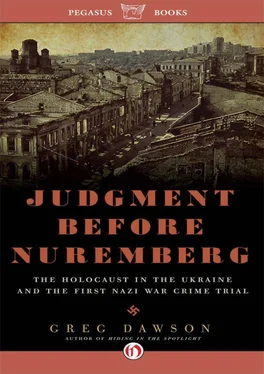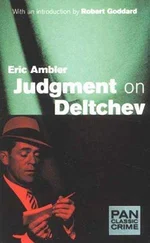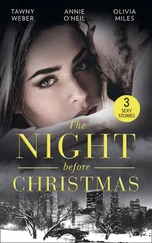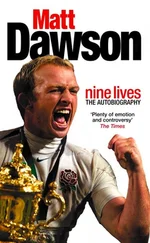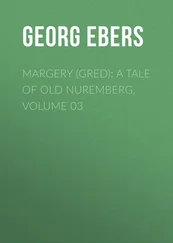This ignorance is the toxic residue of Soviet anti-Semitism coupled with Kremlin policies that pretended there were no ethnic minorities— especially Jews—in the dizzyingly multi-ethnic Soviet Union, just “citizens” and “patriots”—a familiar refrain at the Kharkov trial where the primary victims, Jews, were never mentioned by name. Like nuclear waste at Chernobyl, Soviet attitudes about Jews are proving to have a long afterlife. Writing in 2008, Anatoly Podolsky, director of the Ukrainian Center for Holocaust Studies in Kiev, observed that “Ukrainian society seems incapable or unwilling to perceive its national history as a history of various cultures. This is leading to a situation in which Ukrainian society, especially the younger generation, does not know the background to the Holocaust in Ukraine. A notion has even taken hold that the Holocaust took place exclusively in Western Europe and is not of any importance to Ukraine. The fact that the Jews were the Nazis’ chief victims is being obscured.” [1] Anatoly Podolsky, “A Reluctant Look Back: Jews and the Holocaust in Ukraine,” Osteuropa (2008), 4–5.
Podolsky’s anecdotal impressions were confirmed by Elena Ivanova, professor of psychology at Kharkov National University, who conducted a study in 2002 among 107 students, ages fifteen to seventeen, from private, public, and Jewish schools in Kharkov. They had forty-five minutes to write essays in response to this prompt: “Please write about the Holocaust (the mass extermination of Jews during the Second World War).” She put the definition of Holocaust in parentheses, Ivanova noted, because “the word was still not in widespread use in Ukraine” in 2002.
“The youngsters were clearly surprised, if not taken aback, when they read the essay assignment,” Ivanova reported. “They began to exchange glances, laugh, and whisper back and forth. It was obvious that they had never written about anything like this and perhaps had never spoken about it. As the essays would show, many had not really heard about the Holocaust and, according to several students at one of the schools, it had not even been mentioned in their history lessons. It was obvious how difficult it was for the students to write anything on the subject.” [2] Elena Ivanova, “Ukrainian High School Students’ Understanding of the Holocaust,” Holocaust and Genocide Studies (Winter 2004), 406–407.
This was hardly surprising. Soviet textbooks studiously ignored the Holocaust. It was officially included in secondary school curriculums in Ukraine in the 1990s after the collapse of the Soviet Union, but in the U.S. we would call it an unfunded mandate. Dr. Phil would call it passive-aggressive behavior. The ministry of education did not stop teaching of the Holocaust, but also did nothing to promote it, Podolsky said. There were no training programs for teachers, and not enough class time was allotted to the subject. “So we have a situation where the State and Ministry create no formal hurdles for Holocaust teaching, but real possibilities are also non-existent,” Podolsky wrote.
In short, thanks for nothing. And then there were the textbooks, some of which provided “very scant, fragmentary, and even distorted information,” Ivanova observed. One eleventh-grade textbook described the massacre at Babi Yar—the most iconic of killing fields in Ukraine—without ever mentioning that Jews were killed there. It’s little wonder Ivanova found that “Most students were informed about the Holocaust, but their knowledge was superficial. Most had a murky idea about anti-Semitism as a phenomenon, and did not link it directly to the Holocaust.” [3] Ivanova, Holocaust and Genocide Studies (Winter 2004), 417.
This is how you “teach” the Holocaust without really teaching it—by leaving important lessons unlearned. “The number of students manifesting anti-Semitic and racist views was quite large, as was the number more generally under the sway of stereotypes and prejudices,” Ivanova concluded. “All of this speaks to the fact that a serious labor of enlightenment is essential in order to overcome negative views and prejudices,” especially ones that have been latent in society for centuries. [4] Ivanova, Holocaust and Genocide Studies (Winter 2004), 418.
This is happening in Kharkov through the labors of Rabbi Moskovitz and numerous Jewish organizations—day schools, cultural centers, and the like—which operate freely though with tight security, as I experienced. The Jewish Agency for Israel on Pushinskaya Street, where I passed through an entrance with armed guards, is among the organizations offering Holocaust literature, teaching guides, programs, and other material free of the state’s softfocus filtering. The Kharkov Holocaust Museum, opened in 1996 and unequivocal in presenting the Holocaust as a Jewish catastrophe, is now a popular destination for school groups.
I asked the rabbi about the level of anti-Semitism in Kharkov today.
“Government anti-Semitism is non-existent,” he said. “People-to-people anti-Semitism? I think it exists everywhere. Here it is not worse than other countries.”
The task of teaching the Holocaust in Ukraine and healing its wounds is complicated by the fact that not everyone was on the same side. Collaboration with the Nazis by Ukrainians— some Ukrainians—remains a very big pink elephant in the room as the Ukraine attempts to reconcile with its past. Rabbi Moskovitz said of his father, “He always knew that Ukraine is a place where they (Germans) killed the Jews. And he said the Ukrainians were even worse.” Ukraine is still recovering from the civil war within the war against Germany. And unlike the American civil war, in which North and South occupied separate domains, Ukrainian collaborators and patriots shared the same space and passed each other on the street every day. Their sons and daughters still do. To appreciate the magnitude of the pink elephant in Ukraine, take the testy semantic squabble in the U.S. over “civil war” versus “war between the states” and multiply by a thousand.
Two days before I visited Rabbi Moskovitz at the synagogue, we met at an annual ceremony at Drobitsky Yar, where my mother and her sister were destined to die with 16,000 Jews, including their parents and grandparents, had random good fortune not intervened—as it did for the rabbi’s father, who was chosen to work instead of die at Auschwitz. We stood at the base of the majestic monument, shivering in the cold, knowing the 16,000 marched in far worse, clothed in much less that December day in 1941. It would be seventy years before their identity as Jews finally was acknowledged, and honored, in this same place. For Rabbi Moskovitz, it was progress, a milestone of sorts.
“One unbelievable thing that happened in Kharkov was that (Leonid) Kuchma, the president of Ukraine, came to open the monument at Drobitsky Yar in 1992. He walked together with me and the ambassador of Israel from the road all the way down to the monument. This was a big event.”
After returning to Orlando, I transcribed my interview with Rabbi Moskovitz and e-mailed him some follow-up questions. He replied with rabbinical thoroughness and added a postscript.
“As a note from a rabbi, I would like to point out that since we are both children of survivors who miraculously survived the Holocaust, we have an additional mission to spread good in the world—being that we are also part of their miracle. So, whenever we do a mitzvah we are continuing the life of those who perished in the Holocaust.”
You’ll know that man-on-the-street knowledge of the Holocaust in America has taken a giant leap forward when “Righteous Gentiles” are household words equal to “Oskar Schindler.” I can’t say if that will happen in my lifetime, but I’m working it—starting with my mother.
Читать дальше
